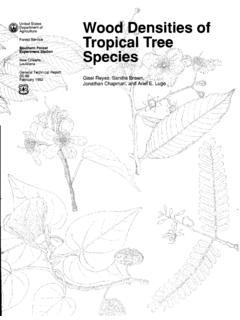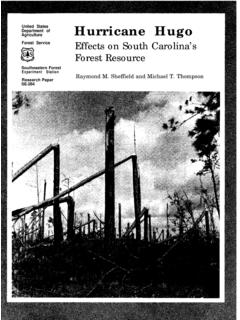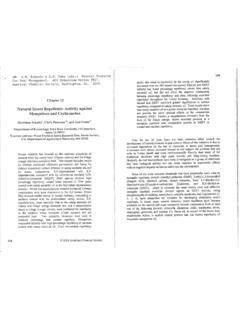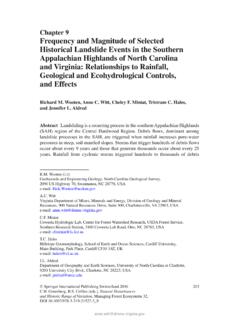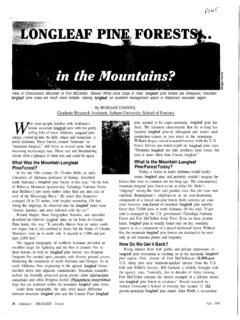Transcription of United States The Southern Appalachians: A History of the ...
1 United StatesDepartment ofAgricultureForest ServiceSouthernResearch StationGeneral TechnicalReport SRS-18 The Southern Appalachians: A History of the LandscapeSusan L. Yarnell_____The Author:_____Susan L. Yarnellis a Researcher with the Forest History Society,701 Vickers Avenue, Durham, NC : Yellow Poplar in the Big Sandy River Valley, Virginia, otherwise noted, all photographs in this publication were provided bythe Forest History Society, Durham, 1998 Southern Research Box 2680 Asheville, North Carolina 28802 ContentsPageIntroduction ..1 prehistory ..2 Paleo-Indian Period ..2 Archaic Period ..2 Woodland and Mississippian Periods ..4 Early History ..6 European Settlement ..8 Early 19thCentury ..9 Civil War and Its Aftermath ..14 Late 19thCentury ..17 Early 20thCentury ..20 Early Conservation in the Southern Appalachians ..24 Great Depression and New Deal ..28 World War II and the 1950 s ..31 Recent Decades.
2 35 Conclusion ..39 Acknowledgment ..39 Literature Cited ..40 AppendixPlant Names ..45 Animal Names ..45iAbstractNatural and geological processes have changed the Southern Appalachianlandscape repeatedly over millions of years. About 12,000 years ago,humans arrived and became important agents of change. People affectedtheir environment by hunting, by spreading the seeds of plants they hadgathered, by disturbing the vegetation around their habitations, and byincreasing the frequency of fires. The extent and degree of humaninfluence increased along with the population. In the Late Archaic period,horticulture expanded the impact of humans on the landscape. The firstEuropeans and Africans reached the Southern Appalachians in the 1500 arrival disrupted American Indian societies with new forms of trade,warfare, and disease. By the late 1700 s, only the Cherokee remained inthe Southern mountains. Thereafter, European settlers and African slavesestablished an economy based on farming, livestock, small-scale industry,and tourism.
3 Market hunting greatly reduced wildlife populations, andgrazing livestock affected vegetation. After reversals during the Civil War,mining, lumbering, and tourism emerged as the largest influences on theenvironment. Deforestation, erosion, pollution, fires, and floods becameprevalent. Concern for conservation grew alongside industry, and, by theearly 1900 s, both public and private agencies were involved in managingthe resources and landscape of the Southern Appalachians. Conservationand resource use have fluctuated throughout the 20thcentury in response toeconomic trends and historical events. Parks and wilderness areas haveprovided refuges for native plants and animals, whereas in national forestsmanagers have sought to regulate resource extraction. Nevertheless,pressure remains intense on the Southern appalachian landscape, andmanagement issues bring contention as different groups seek to use theregion s resources in different : Agriculture, environmental History , lumber industry, mining, prehistory , Southern appalachian , Southern appalachian region is defined primarily bymountains.
4 Hence, its boundaries are vague and defineddifferently for different purposes. In this discussion, theSouthern Appalachians include the State of West Virginia,southwestern Virginia, eastern Kentucky and Tennessee,western North Carolina and South Carolina, northern Georgia,and northeastern Alabama (fig. 1). This largely socialdefinition follows the example of the appalachian RegionalCommission (1973) and studies such as Mountaineers andRangers(Mastran and Lowerre 1983). Although all parts ofthe Southern Appalachians can alternatively be described asparts of other regions or States , their shared characteristicsand identity as a region warrant studying the SouthernAppalachians as a whole. In addition to a mountainouslandscape, these areas share a common History alternatingbetween cultural exchange and isolation from prehistorythrough the modern era. The region falls inside the boundariesof the American South and, thus, shares in the South scolonial, antebellum, and Civil War History .
5 At the same time,the Southern Appalachians are distinguishable politically,economically, and socially from the South as a whole. Understanding the dynamics of the Southern Appalachianlandscape requires an understanding of how that landscapedeveloped. The natural environment of a region is theresult of a long History of change involving geology,climate, disturbance and stability, plants, and animals. TheSouthern appalachian landscape is a very old one, theresult of ancient geological processes and millions of yearsof weathering and climatic change. This long historyresulted in a varied landscape and an exceptionally diverseassemblage of indigenous plants and animals. Althoughnever glaciated, the Southern appalachian climate shiftedas the glaciers advanced and retreated. Variations invegetation and animal species accompanied these climaticshifts as tundra, parkland, and boreal environmentsexpanded and contracted.
6 Remnant populations ofThe Southern Appalachians: A History of the LandscapeSusan L. YarnellFigure 1 Southern appalachian Region as defined in this species found permanent niches within thevaried topography and microclimates of the SouthernAppalachians, whereas subtropical and temperate speciescolonized the lower elevations during warmer periods. Local disturbances have also been important to thecomposition and structure of the Southern Appalachianenvironment. Fire, windstorms, ice storms, snow storms,and soil movement have produced a mosaic of vegetationacross the landscape. The degree and aspect of slopes affectrainfall and soil moisture. Catastrophic events, such as largefires and storms, produce even-aged stands of trees withinaffected areas. Both large-scale and single-tree deathsprovide openings for species adapted to disturbance,whereas sites subject to periodic burning favor fire-tolerantspecies, particularly conifers and oak (Fryer 1996: 94 991).
7 Regionally, the result is a patchwork of vegetationreflecting the particular histories of each locale. Humanactivity has also greatly affected the landscape. The role ofhumans in shaping the environment of the SouthernAppalachians has drawn close scrutiny since the rise of theconservation movement during the 19thcentury. At the time,burgeoning mining and lumber industries were makingrapid and conspicuous changes in the landscape. However,the impact of people on their environment has a muchlonger History . Hunting, plant gathering, home building,farming, trade, war, and industries are centuries old, andtheir impact on the Southern Appalachians is centuries oldas well. The following discussion will consider howhumans have affected the Southern Appalachianenvironment. PrehistoryPaleo-Indian PeriodAround 12,000 years ago, humans arrived in the SouthernAppalachians. Fluted stone projectile points dating to thePaleo-Indian period (10,000 to 8,000 ) have been foundthroughout the region.
8 Manufactured from local stone, thepoints indicate Paleo-Indians were inhabitants of theSouthern Appalachians rather than migrants or occasionalvisitors (Purrington 1983: 108). At the time of Paleo-Indianarrival, the Southern appalachian climate was cooler andwetter than it is today. Boreal forests of spruce and pinewith open parklands still dominated the landscape. By theend of this period, however, mixed oak- hickory forestsbecame predominant with spruce remaining only at thehighest elevations (Delcourt and others 1985). As the environment changed, its human occupants are generally characterized as small bands ofnomadic hunters who relied on large game, particularlymegafauna such as mammoths and mastodons. Megafaunalremains from the Big Bone Lick site in Kentucky may pointto Paleo-Indian reliance on large game. However, evidencefrom other areas of Eastern North America suggests broaderuse of resources including white-tailed deer, elk, smallgame, birds, fish, and plant foods.
9 As the climate changed,these resources increased in importance as the basis ofPaleo-Indian subsistence (Tankersley 1990: 91). Paleo-Indian archaeological sites in the northern ShenandoahValley of Virginia include settled base camps near sourcesof stone for tool production with hunting sites in uplandareas. This pattern of sites suggests long-term occupation ofspecific territories rather than wide-ranging migration. Mostother finds in the Southern Appalachians are from uplandareas, and probably resulted from Paleo-Indians hunting forgrazers on tundra habitats (Purrington 1983: 107 109).Archaic PeriodThe Early Archaic period (7,500 to 5,500 ) continuedthe pattern of base camps and upland hunting. Rock sheltersites from northern Alabama to eastern Kentucky haveyielded the remains of butchered animals, including deer,elk, beaver, bird, and turtle (DeJarnett and others 1962,Jefferies 1990: 206). Likewise, tools made from local stoneoccur in many areas (Purrington 1983: 110 121).
10 Incontrast, sites in the Great Smoky Mountains and PisgahNational Forest contain tools made of stone from the Valleyand Ridge province to the west. These findings may indicatethat groups living in the Valley and Ridge area used the highmountains only as a hunting territory. Tools made of localmaterials do not appear here until near the end of the EarlyArchaic period. Rather than residential remains, SmokyMountain sites yield evidence of hunting, flintworking,butchering, hideworking, and woodworking (Bass 1977: 51,67; Purrington 1983). Of course, undiscovered residentialsites may exist in the appalachian Summit area. If so, use ofnonlocal stone may indicate an exchange network betweenthe regions (Chapman 1985: 148). Hunting-related activities also occurred at residential addition, plant-processing tools, such as manos andmetates, document the gathering of plants around residentialsites; such tools are not in evidence at upland sites.
